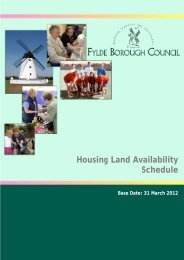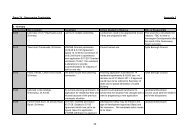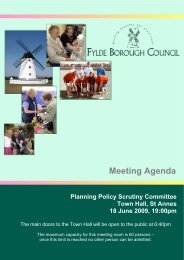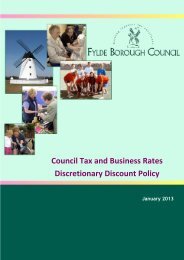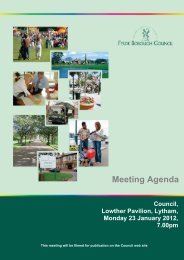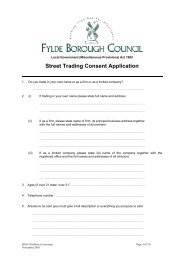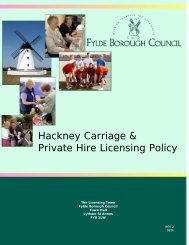Emergency Plan - Fylde Borough Council
Emergency Plan - Fylde Borough Council
Emergency Plan - Fylde Borough Council
Create successful ePaper yourself
Turn your PDF publications into a flip-book with our unique Google optimized e-Paper software.
<strong>Emergency</strong> <strong>Plan</strong> February 2007<br />
5.3 Flood Warning<br />
A FLOOD WARNING will be issued by the Environment Agency North West via their Flood<br />
Warnings Direct system when there is a forecast that one or both of the next two high tides will<br />
meet one or other of the following criteria:-<br />
a) Tide height plus surge >=5.0m AOD at Liverpool (9.9m ACD at Fleetwood) and wind<br />
speed is force 8 from the quadrant SW to NW<br />
b) Tide height plus surge >=5.5m AOD at Liverpool (10.4m ACD at Fleetwood)<br />
irrespective of wind speed.<br />
On receipt of a FLOOD WARNING the Tidal Flooding Officer should:-<br />
• Continue to liaise with the Head of Operations and the Flooding Co-ordinator regarding<br />
the escalating situation.<br />
• Inform <strong>Fylde</strong> Direct or the <strong>Council</strong>’s Out of Hours Service, if out of normal office hours, of<br />
the escalation in the situation and advise them to continue to direct calls for assistance to<br />
the Environment Agency’s FLOODLINE telephone number or website. (see paragraph<br />
5.6 for suitable message).<br />
• Assess and monitor the conditions on site for at least four hours preceding high water.<br />
• Continue to maintain contact with the EA Flood Warning Officer at the control room<br />
(01772 714225)<br />
• Establish contact with Lancashire County <strong>Council</strong> <strong>Emergency</strong> <strong>Plan</strong>ning Unit and obtain<br />
from them details of the nominated Police Flood Liaison officer.<br />
• Continue to monitor weather forecasts.<br />
• If considered necessary following consultation with the Head of Operations and the<br />
Flooding Co-ordinator, set up a Flooding Control Room at Freedom House, Snowdon<br />
Road, St. Annes.<br />
• Request further assistance from Tidal flooding Assistants if necessary.<br />
• Maintain regular contact with all Assistant Tidal Flooding Officers and emergency<br />
response staff to continuously monitor the overall situation and determine priorities.<br />
• Dispatch the Tidal Flooding Assistants to the areas where they are most needed.<br />
• Confirm with Rainfords that they have protected the relevant beach access points.<br />
• Consider the need and prepare for the possible evacuation of the public in areas of risk.<br />
• Maintain an operational log of all events (see Appendix 7 of <strong>Fylde</strong> B.C. <strong>Emergency</strong><br />
<strong>Plan</strong>).and ensure all assistants maintain a detailed personal log<br />
The Head of Operations should:-<br />
• Mobilise resources as necessary, including emergency response staff plant, sandbags<br />
etc to the areas where they are most needed.<br />
• Arrange for vulnerable council buildings at particular risk of flooding (which may include<br />
the Town Hall) to be protected with sandbags as necessary.<br />
• Call out additional <strong>Council</strong> resources as necessary.<br />
• Consider the need for further resources from external organisations. Consult with and<br />
obtain the approval of the Chief Executive as necessary.<br />
The Flooding Co-ordinator should:-<br />
• Inform the <strong>Council</strong>’s Chief Executive of the escalating situation.<br />
Appendix 5<br />
11<br />
Uncontrolled if Printed<br />
Rev.0




